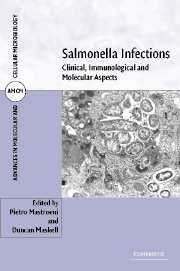Book contents
- Frontmatter
- Contents
- List of contributors
- Preface
- 1 Epidemiological and clinical aspects of human typhoid fever
- 2 Antibiotic resistance in Salmonella infections
- 3 Host-specificity of Salmonella infections in animal species
- 4 Public health aspects of Salmonella enterica in food production
- 5 The Salmonella genome: a global view
- 6 Pathogenicity islands and virulence of Salmonella enterica
- 7 In vivo identification, expression and function of Salmonella virulence genes
- 8 Mechanisms of immunity to Salmonella infections
- 9 Interactions of S. enterica with phagocytic cells
- 10 Interactions between Salmonella and dendritic cells: what happens along the way?
- 11 Immunity to Salmonella in domestic (food animal) species
- 12 Newer vaccines against typhoid fever and gastrointestinal salmonelloses
- 13 S. enterica-based antigen delivery systems
- Index
- Plate section
- References
7 - In vivo identification, expression and function of Salmonella virulence genes
Published online by Cambridge University Press: 04 December 2009
- Frontmatter
- Contents
- List of contributors
- Preface
- 1 Epidemiological and clinical aspects of human typhoid fever
- 2 Antibiotic resistance in Salmonella infections
- 3 Host-specificity of Salmonella infections in animal species
- 4 Public health aspects of Salmonella enterica in food production
- 5 The Salmonella genome: a global view
- 6 Pathogenicity islands and virulence of Salmonella enterica
- 7 In vivo identification, expression and function of Salmonella virulence genes
- 8 Mechanisms of immunity to Salmonella infections
- 9 Interactions of S. enterica with phagocytic cells
- 10 Interactions between Salmonella and dendritic cells: what happens along the way?
- 11 Immunity to Salmonella in domestic (food animal) species
- 12 Newer vaccines against typhoid fever and gastrointestinal salmonelloses
- 13 S. enterica-based antigen delivery systems
- Index
- Plate section
- References
Summary
INTRODUCTION
Any determinant that enables a Salmonella serotype to enter a host, to find a unique niche to multiply, to avoid or subvert the host defenses, to cause disease and to be transmitted to the next susceptible host may be considered a virulence determinant. Essential genes required for growth in standard laboratory medium are usually not included under this broad definition of virulence genes. The total number of virulence genes present in the Salmonella genome can be estimated by screening a bank of mutants generated by random transposon mutagenesis using an animal model of infection. The genome of Salmonella enterica serovar Typhimurium strain LT2 contains 4552 intact open reading frames (McClelland et al., 2001). Of these, approximately 490 genes are essential during growth in rich medium (Knuth et al., 2004). Thus, only the function of about 4062 genes is assessed when S. enterica serovar Typhimurium transposon mutants are generated and analyzed. Analysis of 197 randomly generated transposon mutants of S. enterica serovar Typhimurium for virulence in mice upon intra gastric infection identified 8 mutants that were more than 1000 fold attenuated (Bowe et al., 1998). Extrapolating to the actual number of intact genes present in the genome (4062 genes) this study suggests that mutations in approximately 165 S. enterica serovar Typhimurium genes result in attenuation of more than 1,000-fold in mice.
- Type
- Chapter
- Information
- Salmonella InfectionsClinical, Immunological and Molecular Aspects, pp. 173 - 206Publisher: Cambridge University PressPrint publication year: 2006



